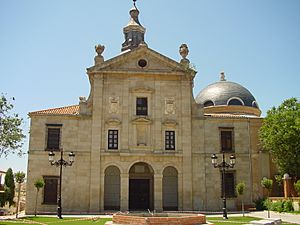Monastery of Inmaculada Concepción (Loeches) facts for kids
Quick facts for kids Monastery of Inmaculada Concepción |
|
|---|---|
| Native name Spanish: Monasterio de la Inmaculada Concepción |
|
 |
|
| Location | Loeches, Spain |
| Website | https://monasterioloeches.org/ |
| Official name: Monasterio de la Inmaculada Concepción | |
| Type | Non-movable |
| Criteria | Monument |
| Designated | 1982 |
| Reference no. | RI-51-0004585 |
| Lua error in Module:Location_map at line 420: attempt to index field 'wikibase' (a nil value). | |
The Monastery of the Immaculate Conception (Spanish: Monasterio de la Inmaculada Concepción) is a special place where Dominican nuns live and pray. It's located in the Spanish town of Loeches, right across from the main town square. People sometimes call it "The Big Convent" (El Convento Grande). This important building was officially recognized as a "Cultural Interest Asset" (Bien de Interés Cultural) in 1982, meaning it's a protected historical monument.
Contents
A Look Back: The Monastery's Story
The monastery was started in 1640 by Gaspar de Guzmán y Pimentel. He was the Count-Duke of Olivares, a very powerful advisor and close friend to King Philip IV of Spain. After his death, his nephew, Luis Méndez de Haro, finished the building work.
Art and Treasures
Over time, the monastery became famous for its amazing collection of paintings. King Philip IV gave many art pieces to the Count-Duke of Olivares, and the nuns' families also donated beautiful works. The collection included art by famous artists like Alonso Cano, Rubens, Tintoretto, and Paolo Veronese.
The French Invasion and Lost Art
Sadly, in 1809, during the French invasion of Spain, a general named Horace Sebastiani de la Porta took many of these valuable artworks. They were carried off to France. Today, you can see some of these paintings in famous museums like the Louvre in Paris. Other pieces are now in museums like the National Gallery of London and the John and Mable Ringling Museum of Art in Florida, USA.
Modern Day Patronage
Today, the monastery is supported by the House of Alba. This is a very old and important noble family in Spain. They are the current counts-dukes of Olivares, continuing the legacy of the monastery's founder.
The Alba Family's Special Burial Place
In 1909, Jacobo Fitz-James Stuart y Falcó, who was the 17th Duke of Alba, added a special chapel to the monastery. This chapel became a "pantheon," which is a grand burial place for important families. It was designed by Juan Bautista Lázaro de Diego, who was inspired by the chapel at El Escorial, another famous Spanish building.
Who Rests Here?
This mausoleum is mainly where the leaders of the House of Alba family are buried. It holds the remains of many dukes and duchesses, starting with Jacobo Fitz-James Stuart y Ventimiglia, the 15th Duke of Alba.
One notable person buried here is María Francisca de Sales Portocarrero, 16th Duchess of Peñaranda. She was the sister of Eugenia de Montijo, who became the Empress of France. Her mausoleum was created by the artist Charles Gumery.
See also
 In Spanish: Monasterio de la Inmaculada Concepción (Loeches) para niños
In Spanish: Monasterio de la Inmaculada Concepción (Loeches) para niños

